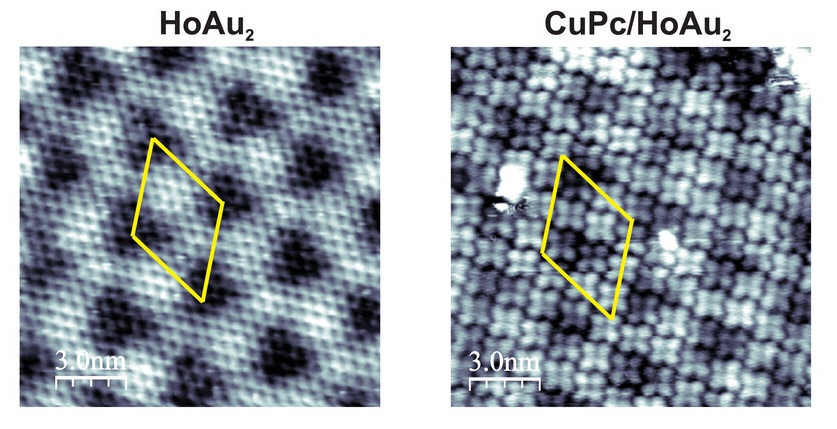Inducing an antiferromagnetic exchange coupling at a hybrid metal–organic interface
Molecular spintronics is an emerging field that combines ferromagnetic materials with organic or metal–organic semiconductors. It benefits from the unique and exceptional properties of organic molecules, which go beyond inorganic ones. The strong response of many organic molecules to electrical, optical, ferromagnetic or antiferromagnetic stimuli bring new potential functionalities to the spintronic device.
An effective spin tunnelling between the ferromagnet and the organic molecule is governed by the so-called spinterface that is formed by the hybrid interface between both materials. The spinterface is defined on the one hand by the energy level alignment between molecule and ferromagnet, and on the other hand by its anisotropy and the interfacial magnetic exchange interaction. It is thus desirable to be able of controlling both energy level alignment and magnetic interaction.
The energy level can be tuned by choosing the molecular species having convenient functional groups. Tailoring magnetic interactions is more difficult. Several authors have modified the interfacial exchange interaction between a ferromagnetic electrode and organic molecules by the incorporation of spacers like graphene, oxygen atoms or a Cu layer in systems formed by phtalocyanine or porphyrin molecules adsorbed on ferromagnetic Ni or Co surfaces. Consequently, the natural ferromagnetic interfacial exchange interaction has been turned into an antiferromagnetic one, which is a relevant feature in the design of molecular spintronic devices.

Now, a team of researchers explored 1 an alternative way of achieving an interfacial antiferromagnetic exchange interaction by combining a ferromagnetic single-atom thick layer that incorporates gadolinium (Gd) and holmium (Ho) atoms (RE atoms) with a single monolayer of organic molecules that include transition metal atoms. The researchers are able to show that the incorporation of 4f RE atoms to hybrid metal–organic interfaces constitutes a feasible approach toward on-demand magnetic properties and functionalities.
For this purpose, the team adsorbed copper phthalocyanine (CuPc) molecules on ferromagnetic GdAu2 and HoAu2 single atomic layers. The GdAu2 and HoAu2 substrates differ in their magnetic anisotropy behaviour. Remarkably, the HoAu2 surface promotes the inherent out-of-plane anisotropy of CuPc, owing to the match between the anisotropy axis of substrate and molecule.
Importantly, the presence of RE atoms leads to a spontaneous antiferromagnetic exchange coupling at the interface, induced by the 3d–4f superexchange interaction between the unpaired 3d electron of CuPc and the 4f electrons of the RE atoms.
It is shown that 4f RE atoms with unquenched quantum orbital momentum (L), as it is the case of Ho, induce an anisotropic interfacial exchange coupling. This effect is a relevant result for the development of magneto-resistive devices with extended functionalities, allowing the modulation of the coupling strength upon a 90° rotation of the external field. A step forward in the field of molecular spintronics.
Author: César Tomé López is a science writer and the editor of Mapping Ignorance
Disclaimer: Parts of this article may have been copied verbatim or almost verbatim from the referenced research paper/s.
References
- M. Blanco-Rey, R. Castrillo, K. Ali, P. Gargiani, M. Ilyn, M. Gastaldo, M. Paradinas, M. A. Valbuena, A. Mugarza, J. E. Ortega, F. Schiller, L. Fernández (2024) The Role of Rare-Earth Atoms in the Anisotropy and Antiferromagnetic Exchange Coupling at a Hybrid Metal–Organic Interface. Small doi: https://doi.org/10.1002/smll.202402328 ↩